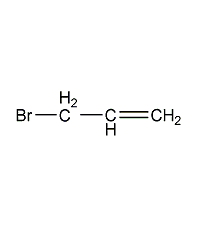
Structural formula
| Business number | 02U9 |
|---|---|
| Molecular formula | C3H5Br |
| Molecular weight | 102.98 |
| label |
propenyl bromide, Propylene bromide, Allyl bromide, 3-bromopropene, 3-bromo-1-propene, Allyl bromide, 3-bromopropene, 3-bromo-1-propene, Bromallylene, 1-Bromo-2-propene, 1-Propene,3-bromo-, 3-Bromo-1-propen, 3-Bromo-prop-1-ene, 3-Bromo-propen, 3-Brompropen, Allylbromid, Allylbromide(3-bromopropene), Pharmaceuticals, organic synthesis |
Numbering system
CAS number:106-95-6
MDL number:MFCD00000244
EINECS number:203-446-6
RTECS number:UC7090000
BRN number:None
PubChem number:24845882
Physical property data
1. Properties: Colorless to light yellow liquid with an unpleasant pungent odor. [1]
2. Melting point (℃): -119[2]
3. Boiling point (℃): 71.3[3]
4. Relative density (water = 1): 1.40[4]
5. Relative vapor Density (air=1): 4.17[5]
6. Heat of combustion (kJ/mol): -1814.8[6]
7. Octanol/water partition coefficient: 1.79[7]
8. Flash point (℃): -1[8]
9. Ignition temperature (℃): 295[9]
10. Explosion upper limit (%): 7.3[10]
11. Lower explosion limit (%): 4.4[11]
12. Solubility: insoluble in water, soluble in ethanol, Most organic solvents such as ether, chloroform, carbon tetrachloride, carbon disulfide, etc. [12]
13. Solubility parameter (J·cm-3)0.5:18.868
14.van der Waals area (cm2·mol-1): 6.370×109
15. van der Waals volume (cm3·mol-1): 45.040
16. Liquid phase standard claims heat (enthalpy) (kJ· mol-1): -12.2
17. Liquid phase standard hot melt (J·mol-1·K-1): 127.4
18. Gas phase standard claimed heat (enthalpy) (kJ·mol-1): 45.2
19. Gas phase standard entropy ( J·mol-1·K-1): 320.48
20. Gas phase standard formation free energy (kJ·mol-1): 74.5
21. Gas phase standard hot melt (J·mol-1·K-1): 78.91
Toxicological data
1. AcuteProperties[13]
LD50: 120mg/kg (orally in rats); 30mg/kg (orally in guinea pigs)
LC50: 10000mg/m3 (rat inhalation, 2h); 4110mg/m3 (mouse inhalation, 2h)
2 .Irritation No information available
Ecological data
1. Ecotoxicity No data available
2. Biodegradability No data available
3 .Non-biodegradability[14] In the air, when the concentration of hydroxyl radicals is 5.00×105/cm3 When, the degradation half-life is 20h (theoretical).
Molecular structure data
1. Molar refractive index: 23.40
2. Molar volume (cm3/mol): 86.3
3. Isotonic specific volume (90.2K ): 192.6
4. Surface tension (dyne/cm): 24.7
5. Polarizability (10-24cm3): 9.27
Compute chemical data
1. Reference value for hydrophobic parameter calculation (XlogP): None
2. Number of hydrogen bond donors: 0
3. Number of hydrogen bond acceptors: 0
4. Number of rotatable chemical bonds: 1
5. Number of tautomers: none
6. Topological molecule polar surface area 0
7. Number of heavy atoms: 4
8. Surface charge: 0
9. Complexity: 17.2
10. Number of isotope atoms: 0
11. Determine the number of atomic stereocenters: 0
12. Uncertain number of atomic stereocenters: 0
13. Determine the number of chemical bond stereocenters: 0
14. Number of uncertain chemical bond stereocenters: 0
15. Number of covalent bond units: 1
Properties and stability
1. Stability[15] Stable
2. Incompatible substances[16] Strong oxidizing agent, strong alkali
3. Conditions to avoid contact[17] Heating
4. Polymerization hazard[18] Polymerization
5. Decomposition products[19] Hydrogen bromide
Storage method
Storage Precautions[20] Store in a cool, ventilated warehouse. Keep away from fire and heat sources. The storage temperature should not exceed 37°C. The packaging must be sealed and must not come into contact with air. They should be stored separately from oxidants and alkalis, and avoid mixed storage. It should not be stored for a long time to avoid deterioration. Use explosion-proof lighting and ventilation facilities. It is prohibited to use mechanical equipment and tools that are prone to sparks. The storage area should be equipped with emergency release equipment and suitable containment materials.
Synthesis method
1. Obtained from the bromination of allyl alcohol: put hydrobromic acid into the reaction tank, add sulfuric acid and allyl alcohol under stirring. Raise the temperature and reflux for 2 hours. When heated to 8°C, the distillate will evaporate. Collect the 68-73°C fraction. After washing with water, dehydrate with anhydrous sodium sulfate and filter to obtain allyl bromide.

2. Preparation method:
p>
![]()
Equipped with a stirrer and dropping funnel , into the reaction bottle of the distillation device, add 250g (48%) hydrobromic acid, slowly add 75g concentrated sulfuric acid, and then add 58g (1.0mol) allyl alcohol. While stirring, add 75g of concentrated sulfuric acid dropwise, heat the reaction bottle, and while adding sulfuric acid dropwise, evaporate the generated allyl bromide, and the reaction will be completed in about 30 minutes. The distillate was washed with 5% sodium carbonate and water, dried with anhydrous calcium chloride, fractionated, and the fractions at 69-72°C were collected to obtain 112g of allyl bromide (1), with a yield of 93%. [22]
Purpose
Used in organic synthesis as an intermediate for resins and spices. [21]


